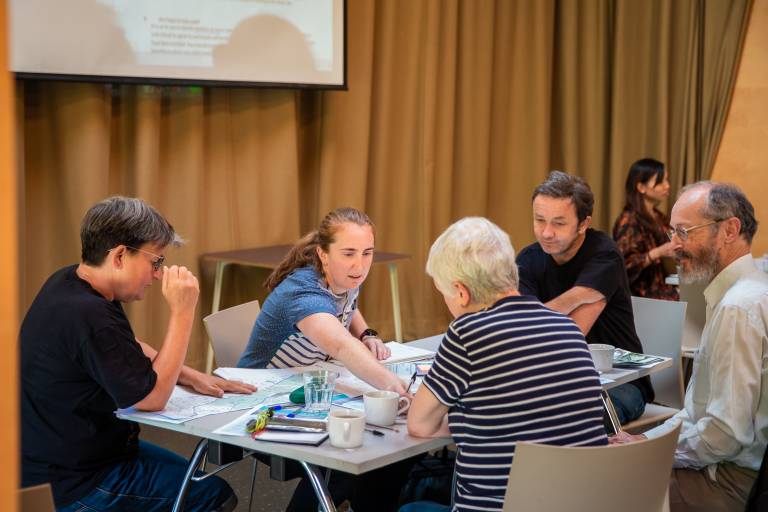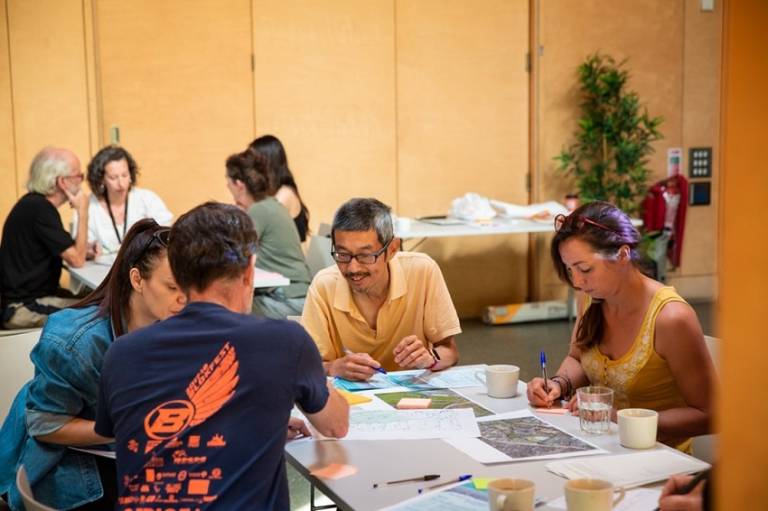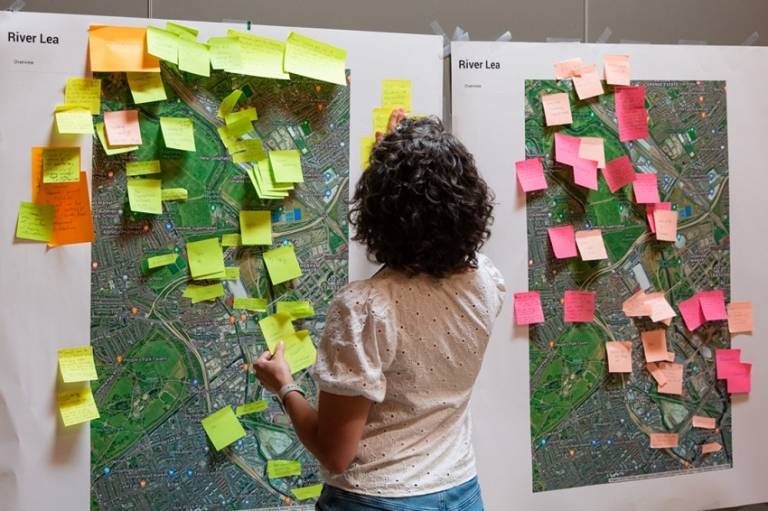Supporting local residents to clean up the River Lea
17 August 2022
The River Lea, which runs through the middle of the UCL East campus, could be a wildlife haven. A new collaboration between local residents and the People and Nature lab is exploring how.

The River Lea, which runs through the middle of the UCL East campus, might be one of the most polluted rivers in the country. Local residents and volunteers are working hard to improve things but can find themselves battling against a lack of resources and support. Researchers from UCL East’s new People and Nature Lab have been finding out how they can help.
In August, residents and volunteer groups with an interest in the River Lea downstream of Walthamstow Marshes were invited to a workshop called ‘The River Lea: Conversations for Action’, hosted by the People and Nature Lab and funded by UCL East’s Community Engagement Fund.

Image: Local residents discussing their concerns about the River Lea. Photo by Kristian Lam-Clark.
The workshop was based on principles of participatory design, where research priorities and processes are defined cooperatively to serve the needs of stakeholders. It was developed with co-design specialists from UCL Geography’s ExCites research group. By using this approach, Principle Investigator, Dr Izzy Bishop (UCL Biosciences) and Co-Investigator Dr Artemis Skarlatidou (UCL Geography) hope to understand how UCL can best support local communities in their fight to improve the river.
Local people have a huge amount of knowledge and experience of and about the River Lea. During the two-hour session, participants identified over 30 separate problems that are impacting a four-mile stretch of river. These included environmental problems (e.g. sewage pollution, invasive species, declining wildlife), social issues (e.g. crime, lack of access to green space), health concerns (e.g. Weil’s disease), and political challenges (e.g. difficulty pursuing legal action against polluters). They also stressed the importance of the river. One participant said, “I walk with my dog and use the Lea for him to swim on a daily basis, and I really care about the river environment”, while another reported that the river is an important location for youth work.
Izzy Bishop says, “urban rivers like the Lea are incredibly important to society. Throughout history the Lea has provided us with drinking water, acted as a major transportation route, and provided a determined geopolitical boundary. It is clear from listening to residents that the river is where people live, learn, teach, play, relax, exercise, and get outdoors. That’s before we consider the fact that it is a fundamental part of the natural ecosystem and therefore supports a huge variety of urban wildlife.”
One crucial element of the event was finding out exactly how the People and Nature Lab can contribute to the ongoing conservation work that is happening locally. Artemis says, “I’ve been overwhelmed by the response of the local people who have shared – and continue to share – masses of information with us about their river. Their knowledge, expertise, and drive to improve the situation is extraordinary. I believe that this event is the start of an exciting ongoing collaboration, and we are already planning what we can do next.”

Image: Dr Lena Ciric reviews resident contributions to a community mapping exercise. Photo by Kristian Lam-Clark.
Dr Lena Ciric (UCL Civil, Environmental and Geomatic Engineering), who is also a member of the People and Nature Lab and helped facilitate the event said “UCL has a wide range of expertise and state of the art equipment that we can use to help answer some of the concerns that the Lea community has. Collaboration with the local community will also offer our students a valuable opportunity to learn and contribute.”

There is obviously huge appetite from local people for any work that might improve the River Lea, but it will take a while for the team to digest everything that they have heard. In the meantime, local charity Thames21, already do a lot of river restoration and community engagement work on nearby sections of the Lea upstream of Tottenham Lock.
This includes citizen science initiatives such as the PlasticBlitz, where volunteers pick up and record plastic litter from riverbanks, and River Ranger, an online app where anyone can report pollution, litter, invasive species, flooding, or drought. We would be delighted to see these initiatives extended to the Lower Lea – anyone can get involved!
Further Information
- Thames21
- Thames PlasticBlitz
- River Ranger
- People and Nature Lab
- UCL East
- UCL Division of Biosciences
- UCL Geography
- UCL Civil, Environmental and Geomatic Engineering
- Dr Lena Ciric
- Dr Artemis Skarlatidou
Contact:
Dr Izzy Bishop | i.bishop@ucl.ac.uk | @FreshwaterIzzy on Twitter
 Close
Close

